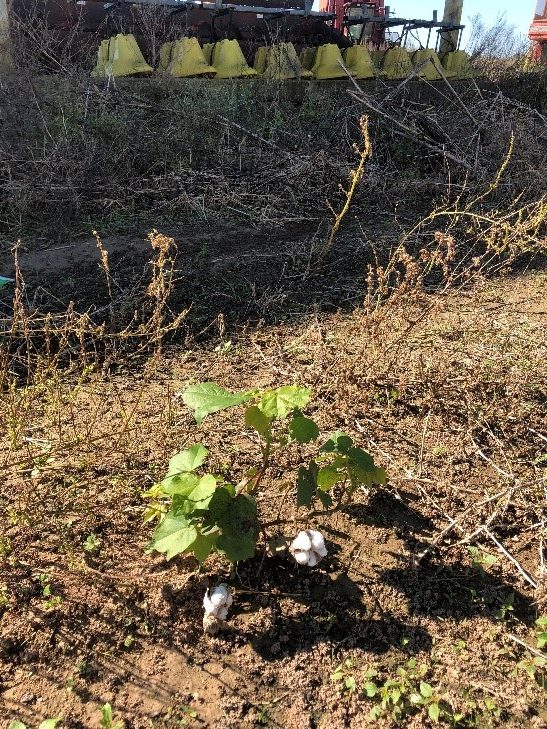by G.D. Morgan and M.A. Matocha, Teeas A&M AgriLife Extension Service
Boll weevils have been found in multiple locations north of the Lower Rio Grande Valley in 2018, including the Coastal Bend and Wintergarden regions. To regain complete boll weevil control, everyone must be diligent, again, about destroying volunteer cotton in gin yards, non-commercial fields, equipment yards, and industrial sites. The information below is focused on gin yards, but will be relevant to the non-commercial cotton areas as well.
With over 80% of the cotton planted in 2018 being XtendFlex® or Enlist™ varieties, controlling volunteer cotton in and around the gin yard has become more of a challenge. Specifically, these Auxin tolerant varieties (XtendFlex® and Enlist™) are tolerant to more herbicides than just dicamba and 2,4-D, including triclopyr (Remedy and other tradenames), fluoxypyr (Starane and other tradenames), and MCPA. Unfortunately, there is no way to tell what herbicide tolerant traits may be found in volunteer cotton plants. As a result, herbicides that will destroy the cotton, regardless of its herbicide tolerant traits, must now be used. Below (Table 1) are herbicides that should effectively kill the volunteer cotton regardless of the herbicide tolerant traits. It should be noted that cotton plant size remains very important. Larger cotton plants are more difficult to destroy with herbicides. Check for volunteer cotton regularly and apply herbicide before cotton reaches the 6-8 leaf stage, if possible. If cotton is larger than the 6-8 leaf stage the chance of regrowth is quite high and secondary applications of herbicide will likely be required for complete kill.
Table 1. Herbicides to consider for managing volunteer cotton in gin yards and other non-field sites. Refer to product label for specific label requirements. These herbicides are not restricted-use and do not require an applicator license to purchase, mix or apply when used according to the label.
| Product (active ingredient) | Trade names* | Rate for Spot treatments | Notes** |
|---|---|---|---|
| Imazapyr+ Diuron | Sahara and Mojave | 0.5 - 1.0 lb per gallon of water + surfactant at 0.25% rate. | -For use in non-cropland areas. -Do not use around desirable plants or drip line of trees due to root uptake and potential injury or death. -Adjuvant required. -Do not use near irrigation ditches. |
| Aminopyralid | Milestone and Milestone VM | 7-14 fl oz per acre See Table 2 below to calculate rate for spot spraying | -For non-cropland, pasture, rangeland, etc. -Do not allow product to come in direct contact with desirable plants, through misapplication or drift. -Injury can occur if applied around desirable trees, use special caution around roses and legume trees. -Adjuvant required. -At the 14oz/a rate not more than 50% of an acre may be treated. |
| *This is not an encompassing list of Tradenames, but includes some of the more commonly recognized. **Refer to product label for specific label requirements. |
|||
Table 2. Amount of Milestone to mix with 1 gallon of water. This table is duplicated from the Milestone Label.
| Gallons per acre | Milestone amount (in mL) to mix to achieve target application rates | |
|---|---|---|
| GPA | 7 fl oz/a | 14 fl oz/a |
| 20 | 10.5 | 21.0 |
| 40 | 5.3 | 10.5 |
| 60 | 3.5 | 7.0 |
| 80 | 2.6 | 5.3 |
| 100 | 2.1 | 4.7 |
| Conversions: 1 tsp = 5 mL 2 Tbsp = 1 fluid oz 30 mL = 1 fluid oz 1 cc = 1 mL |
||

Dr. Gaylon Morgan
State Extension Cotton Specialist
College Station, TX
979-845-2425
gdmorgan@tamu.edu
*This is not an encompassing list of Tradenames, but includes some of the more commonly recognized.
**Refer to product label for specific label requirements.
Table 2. Amount of Milestone to mix with 1 gallon of water. This table is duplicated from the Milestone label.
| Gallons per acre | Milestone amount (in mL) to mix to achieve target application rates | |
| GPA | 7 fl oz/A | 14 fl oz/a |
| 20 | 10.5 | 21.0 |
| 40 | 5.3 | 10.5 |
| 60 | 3.5 | 7.0 |
| 80 | 2.6 | 5.3 |
| 100 | 2.1 | 4.7 |
Conversions: 1 tsp = 5 mL
2 Tbsp = 1 fluid oz
30 mL = 1 fluid oz
1 cc = 1 mL

Dr. Gaylon Morgan
State Extension Cotton Specialist
College Station, TX
979-845-2425
gdmorgan@tamu.edu
